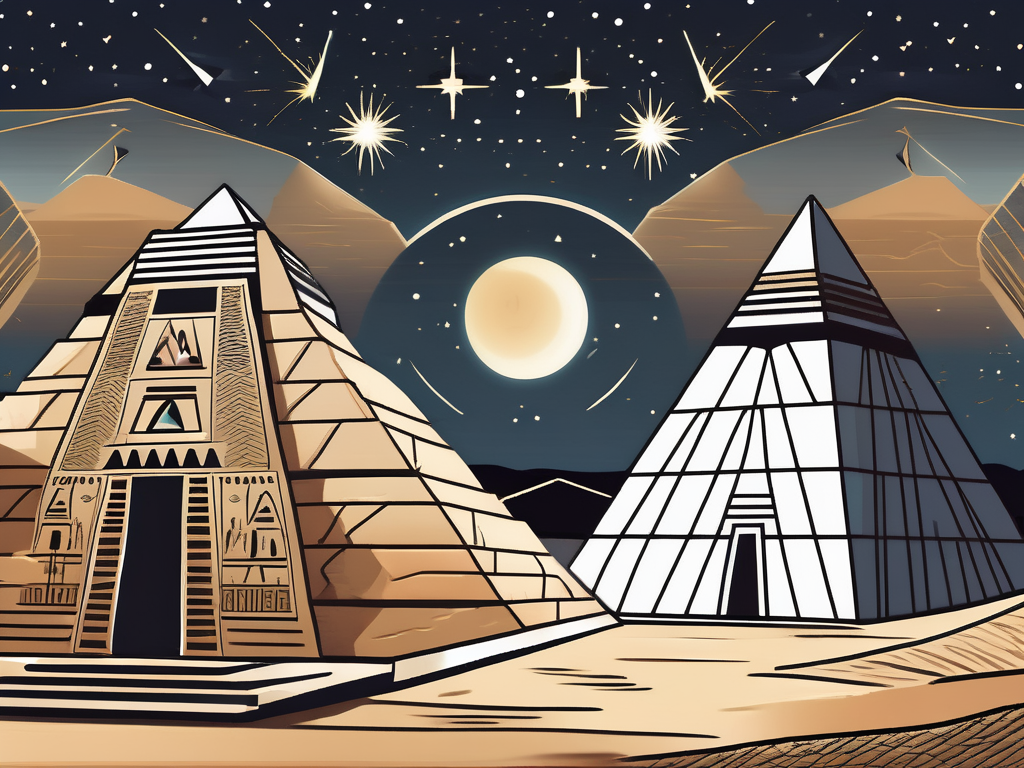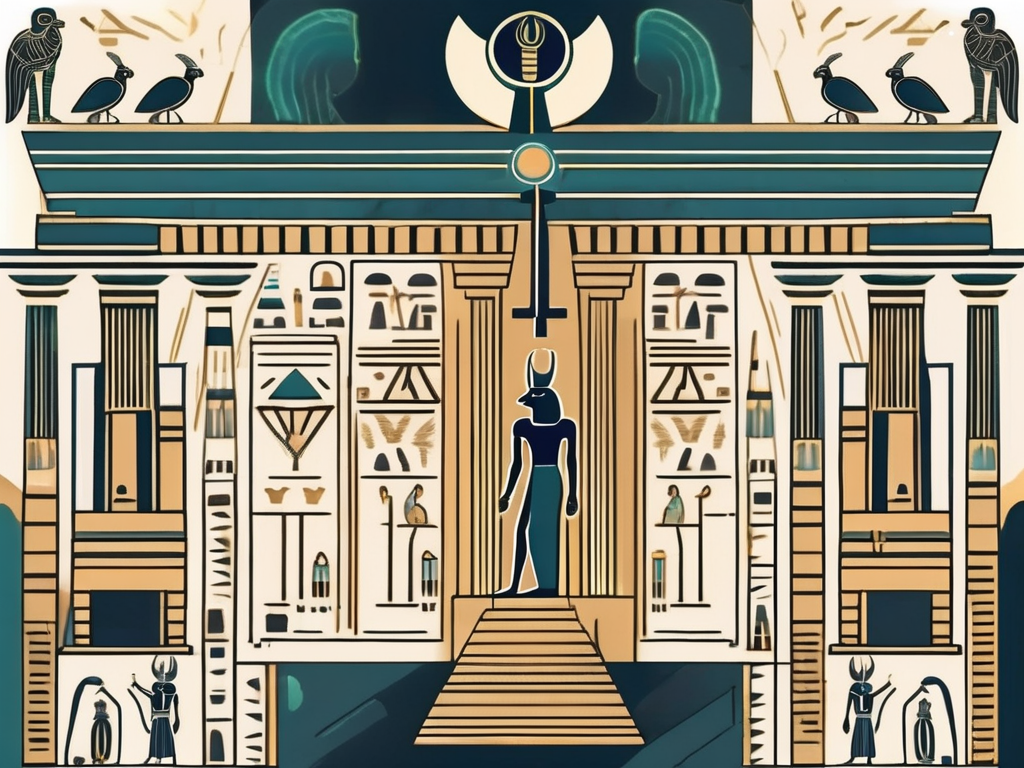Welcome to the fascinating world of ancient Egyptian mythology! In this article, we will delve into the enigmatic world of Pataikos, a deity whose origins and symbolism have captivated scholars and enthusiasts alike. Join us as we unravel the mysteries behind Pataikos, shedding light on his role in ancient Egyptian culture, his intriguing iconography, and even his influence on contemporary society.
Understanding the Origins of Pataikos
Before we can dive deeper into Pataikos’ significance, we must first uncover the origins of this revered Egyptian god. Like many deities in the ancient pantheon, Pataikos’ exact beginnings remain somewhat elusive. Despite this, researchers have identified several key aspects of his mythology that shed light on his importance within the religious framework of ancient Egypt.
According to some scholars, Pataikos may have originated from the merging of multiple local cults and beliefs. It is believed that his worship began in the Delta region of Egypt, where he was venerated as a guardian and protector of households. Over time, his popularity spread throughout the country, and he became an integral part of the Egyptian religious landscape.
Within the rich tapestry of Egyptian mythology, Pataikos holds a unique position. While not as prominent as some of the more well-known gods, such as Ra or Osiris, Pataikos played a vital role in the religious beliefs of the ancient Egyptians. Often depicted as a dwarf-like figure with exaggerated features, Pataikos was believed to possess powers of protection and fertility.
Furthermore, Pataikos was associated with serpents, symbolizing his connection to rebirth and regeneration. His image often included a snake coiled around his arm or leg, reinforcing his role as a deity capable of bringing new life and abundance to the land. This symbolism ties into the beliefs of ancient Egyptians regarding the cyclical nature of the world and the importance of fertility in ensuring prosperity.
It is worth noting that Pataikos’ appearance as a dwarf-like figure may have been influenced by the Egyptian concept of the divine trickster. In Egyptian mythology, the trickster figure often possessed unconventional qualities and characteristics, challenging societal norms and expectations. Pataikos’ unique appearance may have served as a reminder of the unpredictable and transformative nature of the divine.
Pataikos’ Connection with Other Egyptian Gods
As is common in many mythologies, the gods of ancient Egypt often shared intricate relationships and connections with one another. Pataikos was no exception, with his mythology intertwining with various other deities of the pantheon.
One of the most notable connections is Pataikos’ association with the powerful goddess Sekhmet. In some depictions, Pataikos is shown standing under Sekhmet’s foot, signifying his subservience to her. This relationship reflects the belief that Pataikos served as a protector against Sekhmet’s destructive and chaotic tendencies, acting as a balancing force within the cosmology of ancient Egypt.
Furthermore, Pataikos’ association with fertility and abundance aligns him with the goddess Hathor, who was also revered as a deity of fertility and motherhood. Together, Pataikos and Hathor formed a divine duo, ensuring the continuity of life and the prosperity of the Egyptian people.
Another intriguing connection is Pataikos’ association with the god Bes, who was also depicted as a dwarf-like figure. Both Pataikos and Bes were considered protective deities, guarding against evil spirits and malevolent forces. Their shared characteristics and roles highlight the interconnectedness of the Egyptian pantheon and the importance of divine protection in the lives of the ancient Egyptians.
Overall, Pataikos’ mythology and associations reveal a complex and multifaceted deity within the ancient Egyptian religious framework. From his origins as a local household guardian to his connections with powerful goddesses and fellow protective deities, Pataikos played a significant role in the spiritual lives of the ancient Egyptians, ensuring their well-being, prosperity, and protection.
The Iconography of Pataikos
Artistic depictions of Pataikos provide valuable insights into the ancient Egyptians’ perceptions and interpretations of this deity. These representations showcase different aspects of Pataikos’ nature, shedding light on the symbolism and meanings associated with this captivating god.
Pataikos, a deity revered by the ancient Egyptians, was often depicted in their art. These depictions were not only aesthetically pleasing but also held deep cultural and religious significance. Exploring the various artistic representations of Pataikos allows us to delve into the rich tapestry of ancient Egyptian beliefs and gain a deeper understanding of their worldview.
Common Depictions of Pataikos in Ancient Art
When examining ancient Egyptian art, it becomes apparent that images of Pataikos were prevalent and diverse. Although variations exist, certain traits tend to recur in his portrayal. As previously mentioned, Pataikos is often depicted as a dwarf-like figure with exaggerated features, such as an enlarged head and limbs.
The choice to depict Pataikos as a dwarf-like figure is not arbitrary. In ancient Egyptian culture, dwarfs were believed to possess magical and protective qualities. By representing Pataikos in this manner, the ancient Egyptians sought to emphasize his supernatural attributes and his ability to safeguard and guide humanity.
Additionally, Pataikos is frequently shown wearing a headdress consisting of two ostrich feathers, which further emphasizes his association with fertility and regeneration. The ancient Egyptians held a deep reverence for the natural world and believed in the interconnectedness of all living beings. The ostrich feathers symbolize the cycle of life, growth, and renewal, highlighting Pataikos’ role in ensuring the continuity and prosperity of the community.
These artistic representations allow us to visualize the deity and gain a deeper understanding of his importance in the ancient Egyptian worldview. They serve as a window into the beliefs and values of the ancient Egyptians, revealing their profound connection with the natural world and their desire for protection and abundance.
Symbolism and Interpretations of Pataikos’ Imagery
Interpreting the symbolism present in Pataikos’ imagery provides valuable clues about the deity’s significance to the ancient Egyptians. The exaggerated features of his form, for instance, could be seen as a representation of his supernatural attributes, elevating him above ordinary humans.
The ancient Egyptians believed in the existence of a divine realm that governed the natural world. By exaggerating Pataikos’ features, they sought to convey his otherworldly nature and his ability to transcend the limitations of mortal existence. This portrayal served as a reminder of the divine forces at play in their lives and the need to seek the protection and guidance of deities like Pataikos.
The headdress adorned with ostrich feathers not only symbolizes fertility but also serves as a reminder of the interconnectedness between humans and nature, where the balance between the two is crucial for prosperity. The ancient Egyptians recognized the importance of maintaining harmony with the natural world, understanding that their well-being depended on the cyclical rhythms of the earth. Pataikos, with his headdress of ostrich feathers, embodied this delicate balance and served as a guardian of fertility and abundance.
The serpent coiled around Pataikos’ arm or leg reinforces these themes, reiterating the idea of cyclical renewal and the power of transformation in the ancient Egyptian worldview. In ancient Egyptian mythology, serpents were often associated with rebirth and regeneration. The presence of the serpent in Pataikos’ imagery signifies the cyclical nature of life, death, and rebirth, underscoring the ancient Egyptians’ belief in the eternal cycle of existence.
By examining the symbolism and interpretations of Pataikos’ imagery, we gain a deeper appreciation for the ancient Egyptians’ complex religious beliefs and their profound connection with the natural world. The artistic representations of Pataikos not only captivate us with their beauty but also invite us to explore the depths of ancient Egyptian spirituality and the intricate tapestry of their cultural heritage.
Pataikos’ Influence on Ancient Egyptian Culture
Beyond his mythological significance, Pataikos left a lasting impact on ancient Egyptian culture, permeating various aspects of daily life and religious practices. From literary works to religious rituals, the presence of Pataikos can be found throughout this ancient civilization’s history.
Pataikos in Literature and Inscriptions
Ancient Egyptian literature and inscriptions frequently mention Pataikos, highlighting his importance as a protective deity. In these texts, Pataikos is often invoked to safeguard against harm and evil forces. The belief in his ability to ward off malevolent entities served as a source of comfort and protection for the ancient Egyptians.
Pataikos’ Role in Rituals and Ceremonies
The religious practices of ancient Egypt were filled with intricate rituals and ceremonies aimed at pleasing the gods and ensuring their continued blessings. Pataikos played a role in these sacred rites, often invoked for his protective powers during important events.
Whether it was a ceremonial procession or a temple offering, the presence of Pataikos was deemed essential for effectively warding off evil spirits and facilitating the desired outcomes of these rituals. His role in such occasions further highlights the significance attributed to him by the ancient Egyptians.
The Modern Perception of Pataikos
While the ancient worship of Pataikos has long vanished, his legacy continues to resonate within the modern world, particularly in Egypt.
Pataikos in Contemporary Egyptian Culture
Today, Pataikos can still be found in various forms of modern Egyptian culture. Many temples and museums showcase artifacts and artwork featuring this intriguing deity, offering a glimpse into the ancient past and serving as a reminder of Egypt’s rich heritage.
Pataikos’ Impact on Modern Archaeology and Egyptology
From an academic perspective, Pataikos’ mythology has provided archaeologists and Egyptologists with valuable insights into the religious practices and beliefs of ancient Egypt. The study of Pataikos has contributed to our understanding of this fascinating civilization, allowing us to piece together the puzzle of its complex mythology.
By examining the art and religious texts associated with Pataikos, experts have gained a deeper understanding of the ancient Egyptians’ worldview, shedding light on their beliefs, rituals, and the intricate relationships between their gods.
In conclusion, the fascinating deity Pataikos holds a unique place within the pantheon of ancient Egyptian gods. Unveiling the mysteries surrounding this god allows us to gain a greater appreciation for the ancient Egyptians’ intricate religious beliefs, artistic expressions, and cultural practices. As we continue to explore the ancient mythologies of the world, Pataikos’ enigmatic nature and enduring legacy serve as a testament to the profound impact of mythology on human culture throughout history.












